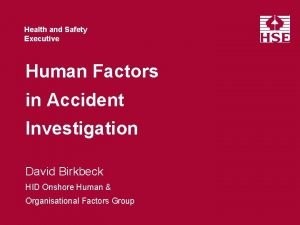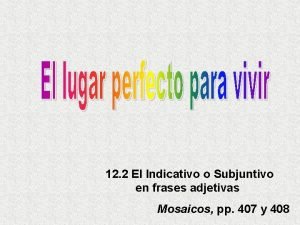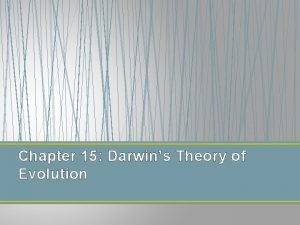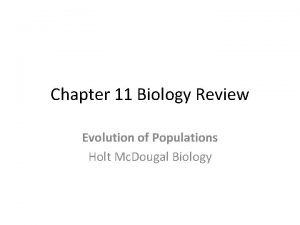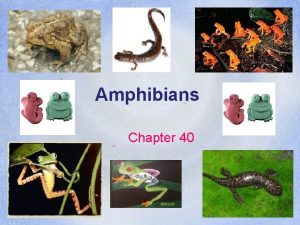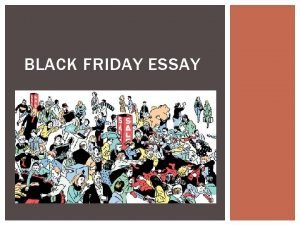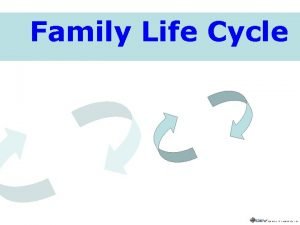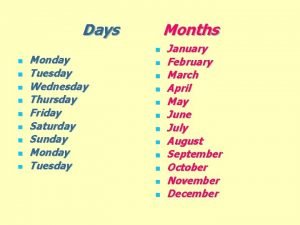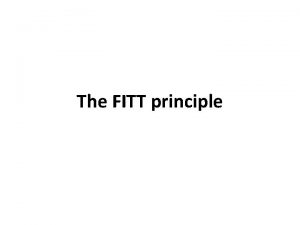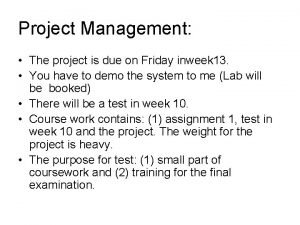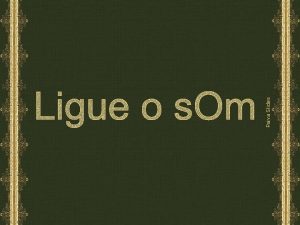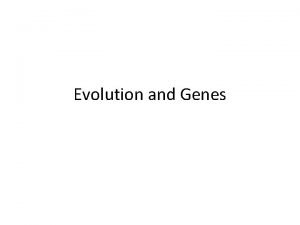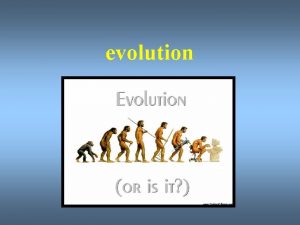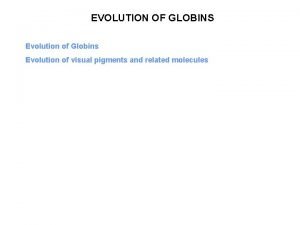EVOLUTION TEST REVIEW SLIDES Test on Friday 407
























































- Slides: 56

EVOLUTION TEST REVIEW SLIDES Test on Friday 4/07

TEST ON TUES. 3/30

Variation in Species Lab • All species have variation. What are some variations you noticed in the size of: – Peas – Grasshopper femurs – Eye width • What are some advantages and disadvantages to these variations? • How do these variations impact evolution? • How did you plot these on a graph and what was the general shape?

GRASSHOPPER FEMUR LENGTH TOTAL DATA 100 # O F H O P P E R S 0 10 20 25 30 35 40 FEMUR LENGTH (mm) 45 50

Bell Curve

TEST ON TUES. 3/30

EVOLUTION BY MEANS OF NATURAL SELECTION

1. What adaptations does this organism have? 2. How did these adaptations evolve? 3. How do they enable the organism to survive in its environment? They have long legs and neck, long, tough, prehensile tongue, and leathery mouth for food gathering. Their coloration is protective. They are tall with good eyesight for watchfulness. Giraffes have high blood pressure (240/160) for pumping blood to the brain. Long neck for reaching its food source Test on Friday 4/22 (leaves)

EVOLUTION BY MEANS OF NATURAL SELECTION 5 Principles TEST ON TUES. 3/30

1. Variation • All species have variations • Variation is the raw material for natural selection Ex: Variations in giraffes

2. Struggle for Existence • Organisms produce more offspring than can survive. • The environment produces struggles organisms must surpass to survive TEST ON TUES. 3/30

3. Only some survive to reproduce • Some are better able to survive and reproduce (pass on their genes) TEST ON TUES. 3/30

4. Natural selection results in genetic change • Each generation contains an increased proportion of individuals with traits that promote survival and reproduction. • What are some alleles that a successful giraffe might have? • Neck length • Leg length TEST ON TUES. 3/30

5. Species adapt to their environment • Selection makes a population better suited to it’s environment. • The environment determines the direction of genetic change. TEST ON TUES. 3/30

The Peppered Moth

• http: //peppermoths. weebly. com/

Evolution: Another Example! Peppered Moth • There are 2 variations of peppered moth: light and dark • Prior to the industrial revolution – white was favored because the tree trunks were white. Why? • Post-industrial revolution – black became more common. Why? • Why? How do predators and environments drive evolution?

Driving Force of Evolution: Environment/Niche • How can an organisms niche be a selective force?

Another Natural Selection Example Chromosome with gene conferring resistance to pesticide Pesticide application Additional applications of the same pesticide will be less effective, and the frequency of resistant insects in the population will grow Survivor

Driving Force of Evolution: Competition • Limiting factors – any condition of the environment that limits the size of a population • Carrying capacity – The number of organisms that can be supported by a particular ecosystem • Overpopulation - the condition of having a population so dense as to cause environmental deterioration, an impaired quality of life, or a population crash TEST ON TUES. 3/30

Bell Curve

Types of Selection The types of selection relate to the bell curve. The bell curve is altered due to forces of nature favoring certain traits over other. • Stabilizing • Disruptive • Directional – Note about sexual selection: • • • https: //www. youtube. com/watch? v=4 j 7 GSu 99 Lm. Y https: //www. youtube. com/watch? v=Vj. E 0 Kdfos 4 Y https: //www. youtube. com/watch? v=Fjk 40 qfcfj 4 https: //www. youtube. com/watch? v=1 Xk. Pe. N 3 AWIE https: //www. youtube. com/watch? v=W 7 QZnw. Kqopo

Stabilizing – the average is favored, the extremes are eliminated • Clutch size (amount of eggs laid) in starlings is between 3 and 6. • Clutch size is a genetic trait • Why are birds who only lay 1 -2 eggs eliminated from the population? • Why are birds who lay 7 -9 eggs eliminated from the population?

How would the bell curve change to reflect stabilizing selection? TEST ON TUES. 3/30

Directional Selection – Favors one extreme in a population, the other is eliminated • The male widowbird collects females for his “harem” by attracting them by the length of his tail. The longer the tail, the more females he attracts and mates with. • Why aren’t there male widowbirds with short tails? • Why don’t the males tails continue getting longer? TEST ON TUES. 3/30

Selective pressures are environmental factors which may reduce reproductive success in a population and thus contribute to evolutionary change or extinction through the process of natural selection. Examples: • competition • predation • disease • parasitism • land clearance • climate change • pollutants. TEST ON TUES. 3/30


Evolution of Galapagos Finch • http: //www. hhmi. org/biointeractive/originspecies-beak-finch • http: //www. hhmi. org/biointeractive/makingfittest

Convergent Evolution • When organisms of different species are subjected to the same selective pressures, they evolve similar structures. These structures are not due to speciation and there is not a common ancestor. Examples:

Analogous structures TEST ON TUES. 3/30


HOMOLOGY vs. ANALOGY

TEST ON TUES. 3/30


Analogous Structures • Superficially similar. They perform similar functions, but evolved independently of each other due to similar selective forces acting on a population. • Examples?

Homologous Structures Evidence of Evolution • Anatomically similar structures inherited from a common ancestor. Because there was a common ancestor, the descendants of this animal demonstrate modified body parts that evolved through adaptation to various environments. • Some variations in the populations were more favorable and thus allowed the animal to be more successful and spread this modification throughout the population. Descent with modification.

Convergent vs. Divergent Evolution Original Population


Mechanisms of Speciation and Evolution • The raw material for speciation is variation, which comes from sexual reproduction. • Occasionally, a mutation can spur evolution. A mutation can be: – 1. Helpful – 2. Harmful – 3. Neutral

Evidence of Evolution • Fossils – Bones, casts, footprints, amber, ice • • Homologous structures Comparative embryology Vestigial structures Biochemical (DNA and amino acids)


Fossils • Fossils are often found in sedimentary rock, which is formed from layers of silt and sand covering dead organisms. • The oldest are found on the lowest layers, youngest in the upper layers




LA BREA TAR PITS - CALIFORNIA TEST ON TUES. 3/30

Fossils, cont… TEST ON THURS. APRIL 4 TH

Homologous Structures

• • Calf Human Fish Tortoise Salamander Chicken Rabbit hog





Vestigial Structures http: //www. sciencealert. com/watch-proof-of-evolution-that-you-can-find-onyour-own-body

Biochemical/DNA Evidence • The closer the DNA sequences of 2 organisms are, the more closely related they are. –Ex. Humans and chimps have DNA that is 99% identical

END OF TEST MATERIAL TEST ON FRIDAY 4/7
 Ent407
Ent407 Emirates 407
Emirates 407 Csc 407
Csc 407 Indicativo 407
Indicativo 407 A small child slides down the four frictionless slides
A small child slides down the four frictionless slides Ball a has half the mass and eight times
Ball a has half the mass and eight times Nonfiction reading test black friday
Nonfiction reading test black friday Econ
Econ Evidence of evolution
Evidence of evolution Chapter 16 evolution of populations vocabulary review
Chapter 16 evolution of populations vocabulary review Chapter 15 darwin's theory of evolution section 15-1
Chapter 15 darwin's theory of evolution section 15-1 Evolution of populations section 11 review
Evolution of populations section 11 review Evolution jeopardy review game
Evolution jeopardy review game Chapter 15 darwin's theory of evolution section 15-1
Chapter 15 darwin's theory of evolution section 15-1 Origin and evolution of amphibia
Origin and evolution of amphibia Unit test review algebra 2
Unit test review algebra 2 Chapter review motion part a vocabulary review answer key
Chapter review motion part a vocabulary review answer key Uncontrollable spending ap gov
Uncontrollable spending ap gov Narrative review vs systematic review
Narrative review vs systematic review Traditional and systematic review venn diagram
Traditional and systematic review venn diagram Narrative review vs systematic review
Narrative review vs systematic review Monday tuesday wednesday thursday friday calendar
Monday tuesday wednesday thursday friday calendar What did you do in your weekend
What did you do in your weekend Good friday timeline for jesus
Good friday timeline for jesus Friday morning prayer
Friday morning prayer Proper noun for book example
Proper noun for book example Its friday th
Its friday th Internal and external conflict worksheet
Internal and external conflict worksheet Fluency friday
Fluency friday Friday bellwork
Friday bellwork Good friday eve
Good friday eve Sgt friday just the facts
Sgt friday just the facts Black friday opinion essay
Black friday opinion essay Theoretical probability example
Theoretical probability example Wocky mad lib part 1 answers
Wocky mad lib part 1 answers What did you do last saturday
What did you do last saturday The very hungry caterpillar stomachache
The very hungry caterpillar stomachache Family life today
Family life today Good friday poem edwin morgan
Good friday poem edwin morgan Monday tuesday wednesday thursday friday saturday sunday
Monday tuesday wednesday thursday friday saturday sunday Friday bellwork
Friday bellwork Black friday stock market crash
Black friday stock market crash Fitt principle example
Fitt principle example Ethan is dragging a bag of grass
Ethan is dragging a bag of grass Happy friday today
Happy friday today Happy friday
Happy friday It's friday night and skyler has been assigned
It's friday night and skyler has been assigned What did you do in london last weekend
What did you do in london last weekend Sing along song
Sing along song Sherwin williams
Sherwin williams Friday project management
Friday project management Friday night feeling fine
Friday night feeling fine Is due on friday
Is due on friday Friday the 13th igg
Friday the 13th igg Homework is due on friday
Homework is due on friday Homework is due on friday
Homework is due on friday Friday night lights movie script
Friday night lights movie script

